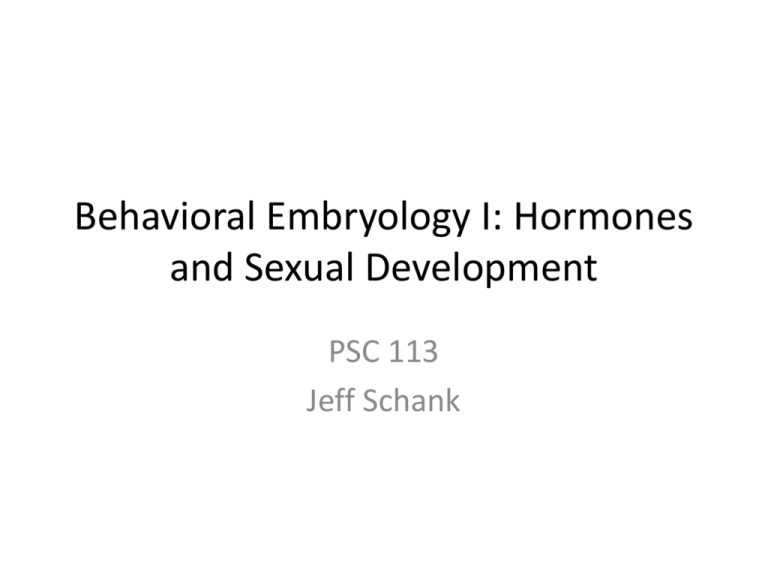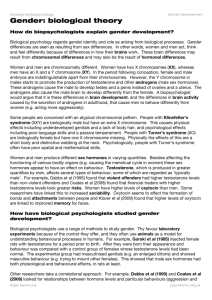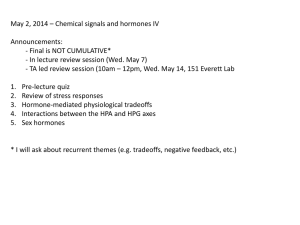Behavioral Embryology I: Hormones and Sexual Development
advertisement

Behavioral Embryology I: Hormones and Sexual Development PSC 113 Jeff Schank Outline • • • • Introduction Ontogenetic Transitions and Adaptations Hormones and Sexual Development Fetal Hormones and the Development of Reproductive Organs – – – – Development of Sex Differences in the Brain Perinatal Hormones and Behavioral Development Gender and Sex Is There a Difference in the Brains of Homosexuals and Heterosexuals Introduction • Ontogenetically, all vertebrates develop from a single celled zygote to an adult form • But, they do it in different ways • Amphibians go through a free living larval stage, which is morphologically and behaviorally different from the adult stage • Fish and Reptiles emerge from their embryonic stages typically similar to adult forms in both behavior and morphology • Mammals and Birds undergo much more gradual and developmental transitions from a neonate (just born mammal or hatched bird) to adult Altricial and Precocial • Definition: The degree of immaturity in neonatal mammals and birds is distinguished in terms of how altricial or precocial they are – Altricial young immature in their sensory and/or motor development requiring substantial parental – Precocial young are more mature in their sensory and/or motor development and require less parental care • For example, humans, rats, mice, many nesting birds all have relatively altricial young requiring considerable parental care • Ducks, deer, cattle, pigs are relatively more precocial at birth and though they require parental care, they need less of it Ontogenetic Transitions and Adaptations • Behavioral Embryology focuses on the development of behavior in young animals, and how these changes are related to morphology, neuoanatomical changes, and hormonal changes • Earlier, we talked a lot about the Umwelten of different organisms, which is their sensorimotor environment that they perceive and react to • Mammals and Birds can go through a succession of Umwelten during development – Consider the difference in Umwelt between a newly born mouse or rat and it more mature stages (blind and deaf, etc.) • During each stage of development, an organism must be able to perform behaviors adaptive to its Umwelt – For example, mammals must be able to nurse and how they do this can be quite different from one mammalian species to the next Types of Transitions • Ontogenetic Transitions: Mammals and birds, must make behavioral transitions from neonatal behaviors to adult behaviors – Early behaviors may be in preparation for later stages of development • Ontogenetic Adaptations: Organisms must also behave in ways that facilitate immediate biological functions – For example, nursing in young mammals or pecking on a parent’s beak or opening the mouth in response to a parent with food Three Hypotheses about Fetal Development • Fetal Activity as an Epiphenomenon: Mammals including humans exhibit spontaneous fetal activity: movement of developing limbs, spontaneous breathing in and out of amniotic fluids – The epiphenomenal view is that all these forms of spontaneous activity are merely the consequences of the developing nervous systems, and are neither adaptive or preparations for postnatal behavior • Fetal Activity as Preparation for postnatal Behavior: On this view, fetal behaviors prepare the way for the further development of behavior – For example, spontaneous breathing may be important for the differentiation of lung tissue and for correcting “bad” intercostal nerve connections with muscle segments (i.e. muscles surrounding the ribs). • Fetal Activity as Ontogenetic Adaptation: On this view, fetal activity may be adaptations to specific environments – For example, fetal rats swallow amniotic fluids – The flow of these fluids over olfactory and taste receptors may help the neonatal rat identify the mother’s body as a food source, e.g., injecting citral into the amniotic fluid of surrounding prenatal rats – Ultrasounds in rat pups? Hormones and Sexual Development • Fetal Hormones and the Development of Reproductive Organs – Sexual development in mammals begins at the time of fertilization with the production of typically two kinds of zygotes XX (female) and XY (male) – It is an excellent example of how sex morphology and behavior is not programmed by the genes – In humans, at 6 weeks of after fertilization, a developing fetus, regardless of its genetic sex has the same pair of primordial gonads – After 6 weeks, testis determining factor (TDF a protein) causes the medulla to develop into a testi – The production of TDF is one of the major function of the Y chromosome Fetal Hormones and the Development of Reproductive Organs • Both males and females have two compete sets of reproductive ducts: – The Wolffian system, which has the capacity to develop into the male reproductive ducts, e.g., seminal vesicles, vas deferens – Müllerian system, which has the capacity to develop into the female ducts e.g., uterus, vagina, fallopian tubes • In the absence of the TDF, the primordial gonads automatically develop into ovaries • In the third month of male fetal development, the testes secret testosterone and Müllarian-inhibiting substance • The development of the Müllarian system occurs in any fetus that is not exposed to testosterone during early development • If male or female gonads are removed, the Müllarian system develops Timing of Sexual Differentiation in the Human Fetus Disorders of Sexual Development Normal Development Androgen insensitivity syndrome (AIS) • A developmental disorder of genetic males in which an insensitivity to androgens causes them to develop female bodies, but not internal female anatomy • Testes develop and release Müllarian inhibiting substance • The testes release lots of testosterone and enough estrogens to feminize the body in the absence of any sensitivity to androgens • AIS comes in degrees and is caused by is a set of disorders of sex development caused by mutations of the gene encoding the androgen receptor • In complete AIS (CAIS), people generally women with internal testes, genetically male, and normal female bodies by external appearance with some exceptions • There can also be partial AIS (PAIS): male or female body, with slightly virilized genitalia or micropenis; testes in the abdomen; sparse to normal androgenic hair Androgen insensitivity syndrome (AIS) CAIS PAIS Adrenogenital Syndrome • • • • A disorder characterized by a decrease in the release of the hormone cortisol from the adrenal cortex, which results in the production of high levels of adrenal androgens and masculinizes the bodies of genetic females It is any of several autosomal recessive diseases resulting from mutations of genes for enzymes mediating the biochemical steps of production of cortisol from cholesterol by the adrenal glands Usually, the onset of this disorder is relatively late in development, and thus does not stimulate the development of the Wolffian system Thus, there is often only partial development of secondary sex characteristic – enlarged clitoris – partially fused labia – if left untreated, leads to unpredictable changes at puberty Adrenogenital Syndrome Perinatal Hormones and Behavioral Development • Most of the research on hormones and behavioral development has focused on the role of hormones in sexual behaviors in laboratory animals • Early research showed that the prenatal injection of testosterone both maculinizes and defeminizes a genetic female’s copulatory behavior (Phoenix CH, Goy RW, Gerall AA, Young WC 1959 Organizing action of prenatally administered testosterone propionate on the tissues mediating mating behavior in the female guinea pig. Endocrinology 65:369–382) • In that study they – injected pregnant guinea pigs with testosterone – When the litters were born, they ovariectomized the female offspring – When these ovariectomized female guinea pigs reached maturity, they injected them with testosterone and assessed their copulatory behavior – They found that the females exposed to prenatal testosterone displayed more male like mounting behavior in adulthood than those who were injected with testosterone but not exposed to testosterone prenatally – When females were injected with estrogen and progesterone, females prenatally exposed to testosterone displayed less lordosis Perinatal Hormones and Behavioral Development • In a complementary study, they also found that the lack of exposure to testosterone feminizes and demasculinized copulatory behavior in adult males • Male rats castrated shortly after birth failed to display the normal male copulatory pattern of mounting behavior when they were injected with testosterone and given access to sexually receptive females. • And when they were injected with estrogen and progesterone, they displayed more lordosis than did castrated control males Gender and Sex • The sexuality of a person or other mammal is not merely a matter of the individual’s genotype (i.e., the presence of X or Y chromosomes). • The hormones one is exposed to pre and postnatally determine to what degree male or female secondary sexual characteristics develop • In addition to biological sex and sex characteristics, there is also the notion of gender • Roughly, gender refers to social or cultural distinctions about masculine or feminine traits, sex refers to the more biological aspects we have talked about • Are gender and sex distinct? • Can the social environment of a person be arranged early in postnatal development so that an individual, which is male or female based on genetic sex, will develop the opposite gender? • The theory that this can be done is the theory of gender neutrality, which states that gender can be socially developed/constructed (perhaps with the help of surgery) independent of the biological sex of the individual The Boy Who was Turned into a Girl Is There a Difference in the Brains of Homosexuals and Heterosexuals? • This question implies more than just a difference • Is there a difference that causes a difference in behavior? • Simon LeVay (Science, 1991), published the results of a postmortem study that compared the neuroanatomy of three groups of subjects: – heterosexual men – homosexual men – women (who were assumed to be heterosexual) • Previous research reporting sex differences in the anterior and preoptic areas of the hypothalamus of various species, focused LeVay’s research on these areas • And as we have seen, the hypothalamus is an important area for sex differences in the brain • Levay found a difference in the volume of the third interstitial nucleus of the anterior hypothalamus (INAH 3) Is There a Difference in the Brains of Homosexuals and Heterosexuals? • • • • • Is the study replicable? (Overlap of brain areas, problems of data mining) What does it really mean? What is the direction of causation? Sexuality in humans has a cognitive component, so the hypothalamus does not hold all the answers Nevertheless, because we do know that hormones effect behavior, changes in hormones can have a variety of causes, hormones can restructure the brain at any developmental stage of the organism, it would not be surprising if these or results like this turn out to be correct. How we are to interpret them is another matter









